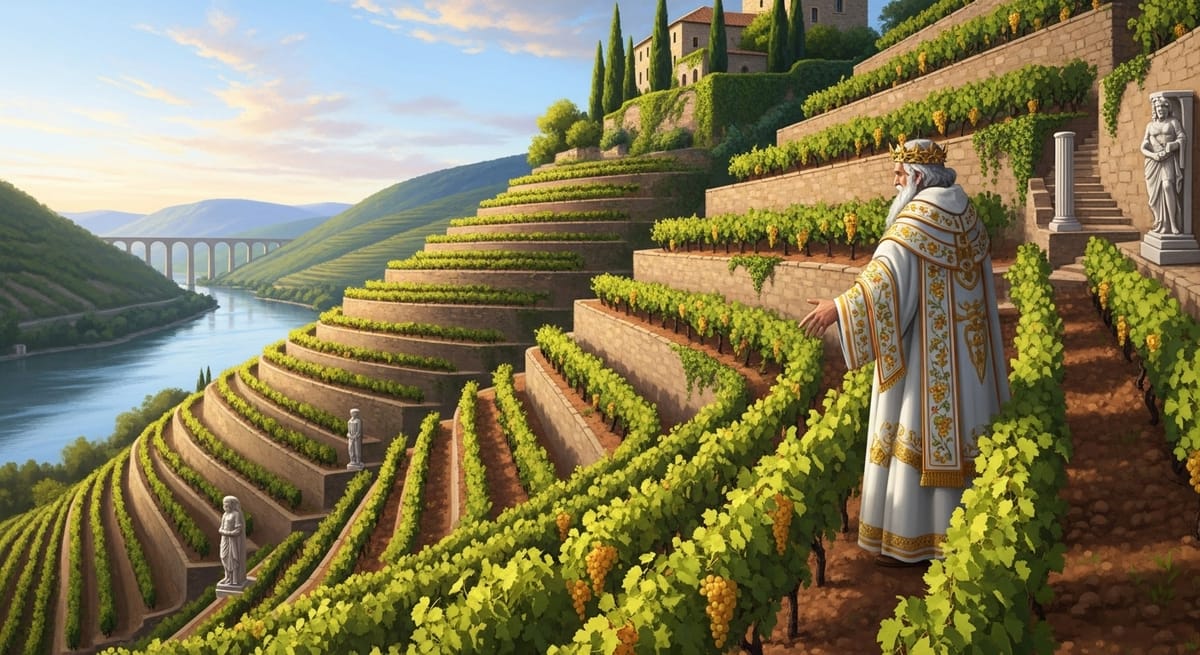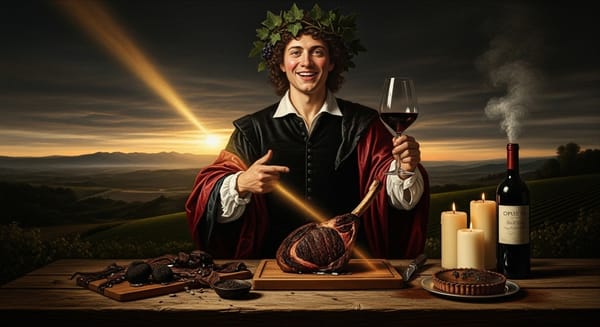A Single Slope, A Singular Soul: The Eternal Allure of Château-Grillet
Explore the story of Château-Grillet — a 3.8-hectare monopole in the Rhône where Viognier achieves timeless perfection. Discover its Roman origins, centuries-old cult status, and the singular terroir behind one of France’s rarest wines

One grape, one vineyard, one voice — how a sliver of Rhône hillside became one of France’s rarest and most poetic wines.
I. Prologue: Where Time Runs Slow
There are places in the wine world where multiplicity reigns — sprawling estates, vast appellations, hundreds of producers and styles. And then there is Château-Grillet.
A vineyard so small it could fit inside a single Bordeaux estate’s garden.
A wine so rare that most mortals will never taste it once.
And a story so singular that even I — Liber, who have walked the vineyards of gods and emperors — pause here in reverence.
This is not a tale of conquest or expansion. This is a story of devotion — to a grape, a slope, a terroir, and an idea.
II. The Origins: A Monopole Born of Empire
Long before modern France was born, the Rhône Valley was a cradle of wine. Roman settlers carved terraces into its steep slopes, training vines to cling to sunlit granite. It was here, on a south-facing amphitheater above the tiny hamlet of Vérin, that the seeds of Château-Grillet’s destiny were planted.
The vineyard was documented as early as the 3rd century, but it truly entered recorded history in 1830, when it was officially recognized as a monopole appellation — one of the very few in all of France. That meant the entire AOC — its mere 3.8 hectares — belonged to a single estate, producing wine from one contiguous plot, one terroir, one voice.
While Bordeaux and Burgundy grew rich on trade and expansion, Château-Grillet remained a world unto itself — an island of Viognier, fiercely protected and impossibly focused.
III. The Grape and the Ground
Viognier is a capricious muse. Too much sun, and it loses its perfume; too little, and it sulks, yielding watery wines. But on the steep granite slopes of Château-Grillet — where terraces catch the morning light and the Mistral wind sweeps the vines clean — Viognier finds its perfect home.
The soils here are ancient: decomposed granite flecked with mica and quartz, draining easily yet forcing the vines to dig deep for sustenance. Yields are tiny — often less than 20 hectoliters per hectare — and each vine must fight for survival. But struggle breeds complexity. The grapes emerge intensely concentrated, their skins glowing gold in the late-summer sun.
And from this concentration comes a wine like no other: rich yet electric, opulent yet taut, with aromas of white peach, apricot, orange blossom, almond, and crushed stone. It is Viognier stripped of vanity — precise, vertical, and sculpted.
IV. The Golden Age: A Cult is Born
For centuries, Château-Grillet remained a closely guarded treasure — the wine of kings, poets, and connoisseurs. Thomas Jefferson tasted it during his tour of France and called it “exquisite.” The Rothschilds collected it. It graced the tables of emperors and tsars.
Yet the estate itself changed little. Family-owned and family-farmed, it resisted modernization and expansion. It was always small, always rare, and always itself.
In the 20th century, under the stewardship of the Neyret-Gachet family, Château-Grillet became even more elusive. They produced the wine with almost monastic secrecy — no grand marketing, no global fanfare. Allocations vanished instantly. Bottles aged for decades in private cellars, their reputations growing almost mythic.
V. A New Era: Artistry Meets Precision
In 2011, a new chapter began when François Pinault — yes, the same titan behind Château Latour and Eisele Vineyard — acquired Château-Grillet. Yet even with new ownership and resources, the philosophy remained unchanged: do less, but do it better.
Pinault’s team undertook a careful renovation of the vineyards, rebuilding crumbling terraces, refining canopy management, and replanting old vines where necessary. In the cellar, precision increased: gentle whole-cluster pressing, meticulous lees stirring, and extended aging in a mix of new and neutral oak.
The result? Wines that maintained Château-Grillet’s ethereal character but gained even more depth, balance, and longevity. The best vintages now age for decades, evolving from exuberant fruit and floral notes into profound layers of spice, honey, and minerality.
VI. Why Château-Grillet Matters
In a world obsessed with volume and visibility, Château-Grillet remains an outlier. Its production is minuscule — barely 10,000 bottles per year — and its influence outsized. It proves that greatness does not require scale, only singularity.
It is also a reminder of what wine truly is: not a commodity, but a conversation between soil, grape, and time. And here, that conversation is intimate and uninterrupted — a single voice speaking clearly across centuries.
VII. Liber’s Reflection: The Beauty of Obsession
I, Liber, have watched humanity build empires on wine. They plant thousands of hectares, chase markets, and brand their bottles with gold. But here, on a quiet hillside above the Rhône, a different truth is whispered: less can be infinite.
Château-Grillet is not a wine for the impatient. It does not shout or posture. It whispers, and in that whisper are layers of meaning — geological, historical, emotional. It is a wine that asks you to slow down, to listen, to feel.
To taste it is to taste focus. Precision. The idea that perfection is not abundance but purity. It is a wine not of ambition but of devotion — and in that devotion, it achieves immortality.
🍑 Final Benediction
Some wines aim to please the many.
Some aim to impress the powerful.
Château-Grillet aims for something greater: to speak the language of one grape, one place, one soul — and to speak it perfectly.





